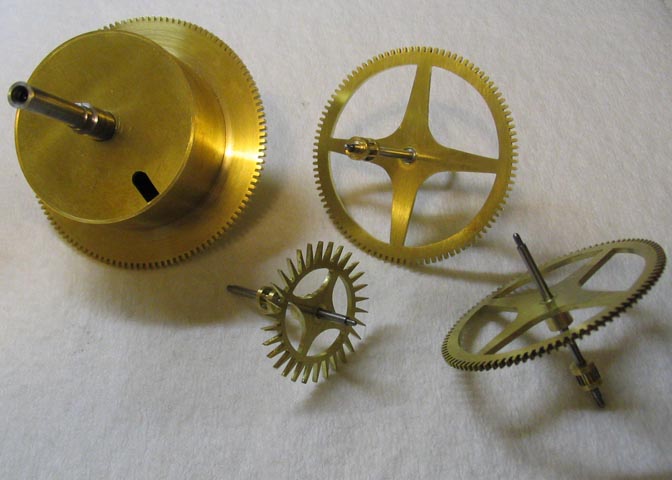Again, a little more done, today.
One more thing to do on the cylinder, then I can get going with the eccentric.
There are two condensate drain valves that go into the side of the cylinder.
The print calls for the valve stems to be made of brass, but I think it would look better if
the valves were made from two different colored metals. The end of the stem has been
cut here, and the seat point cut using the compound slide.
Then the longer part of the stem is turned down to take 4-40 threads.
The material is stainless hex rod. It could be turned from round just as easily. I used hex
rod for a reason.
Once the threads are done, the piece is parted off to length.
The handle part of the valve stem is supposed to be 1/4" diameter. By using hex rod for
this, instead of round stock, I can turn away most of the pointed corners on it, but leave a
small flat. Then, when it comes time contour the "petals", the bits of the flats from the hex
rod can be used to locate them.
Above, the stem/handle on the right is finished, and the one on the left is just getting
started. One of the dished out areas has been filed in using a small round file. (It's a chainsaw
file, actually.) Looking just to the left of that one filed spot, you can see one of the left over
flats from the hex rod. There are six of those spots, of course, and they give you a good way
of spacing the petals of the handle fairly nicely.
After the filing is done the piece is put back into the lathe, and the end is faced off to length.
Rounding off the edges on the two faces of the handle, then drilling holes inside each petal part
will give it an even more realistic appearance. Didn't go quite that far with these.
The body of the valve is a piece of 3/16" brass rod. It's threaded on one end to fit the holes
in the back side of the cylinder, then parted off and flipped end for end to drill the tiny through
hole, and tap the threads that will take the valve stem.
Working on the other end of the valve body, the tap hole has been drilled. It goes about
half way through the piece. Then the smaller hole that will let water flow through it is drilled
the rest of the way through.
In the setup above, a pin vise is being used to drill that smaller hole. The bit is only .040"
diameter, and between that husky drill chuck and the 600 watt motor on the lathe,
it wouldn't have much of a chance if it should bind in the hole. Would snap it like a toothpick.
To prevent problems like that, you can use a pin vise to hold the drill bit, and let it float in
the drill chuck. The jaws of the drill chuck are tightened by hand only enough to start to grip
the pin vise, then backed off a smidge. When actually drilling the hole, the drill chuck isn't used
to apply pressure. It is just there to act as a guide. The pin vise is held lightly between your
fingers, and with the lathe chuck spinning, the bit is fed into the work piece. If it should grab or
bind from cuttings, the pin vise will spin between your fingers instead of breaking off the drill bit.
When the lathe work is done on the two valve bodies, a hole is drilled to meet up with the
end of the threads on the inside. This hole is where the water will come out when first
starting up the cold engine if it's run on steam.
A tiny pipe was made that fits into these holes in the side of each valve body. No pictures
of that. It's just a piece of .093" brass rod drilled through its length to make a tube.
Once those holes are drilled in the side of the valves, the little pipe is soldered in. Then a
tap is run down the threads inside the valves to clean up any solder that may have come
through, and the valve stems are screwed in.
The completed valves are screwed into the cylinder, and that's the days progress.
I think the stainless handles are set off nicely against all the brass stuff. They work well, too.
Putting an aquarium pump to the threaded end of the valve, and turning the handle in and
out, it turned on and off, just like the kitchen faucet.
I did do some other work on the engine today, but it amounted to fitting up. Something else
I had missed earlier. With everything assembled thus far, it seemed tight when rotating the
flywheels. Not the cross head. I had checked that. Then I thought maybe I had cut the piston
rod gland off center, but removing the gland didn't remedy the problem. What I found was the
steam chest valve plate was about .001" long on one end. When the bottom cylinder head was snugged down against the cylinder, that valve plate was holding it up, and the reamed hole that
the piston rod runs in was cocked up just that tiny amount. After dressing it down and
reassembling things, it's nice and smooth.
Eccentric work soon.
Thanks for looking in!
Dean


























